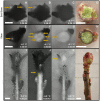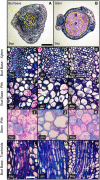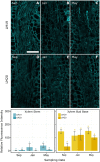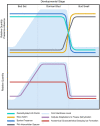Acquisition of Freezing Tolerance in Vaccinium macrocarpon Ait. Is a Multi-Factor Process Involving the Presence of an Ice Barrier at the Bud Base
- PMID: 35599888
- PMCID: PMC9115472
- DOI: 10.3389/fpls.2022.891488
Acquisition of Freezing Tolerance in Vaccinium macrocarpon Ait. Is a Multi-Factor Process Involving the Presence of an Ice Barrier at the Bud Base
Abstract
Bud freezing survival strategies have in common the presence of an ice barrier that impedes the propagation of lethally damaging ice from the stem into the internal structures of buds. Despite ice barriers' essential role in buds freezing stress survival, the nature of ice barriers in woody plants is not well understood. High-definition thermal recordings of Vaccinium macrocarpon Ait. buds explored the presence of an ice barrier at the bud base in September, January, and May. Light and confocal microscopy were used to evaluate the ice barrier region anatomy and cell wall composition related to their freezing tolerance. Buds had a temporal ice barrier at the bud base in September and January, although buds were only freezing tolerant in January. Lack of functionality of vascular tissues may contribute to the impedance of ice propagation. Pith tissue at the bud base had comparatively high levels of de-methyl-esterified homogalacturonan (HG), which may also block ice propagation. By May, the ice barrier was absent, xylogenesis had resumed, and de-methyl-esterified HG reached its lowest levels, translating into a loss of freezing tolerance. The structural components of the barrier had a constitutive nature, resulting in an asynchronous development of freezing tolerance between anatomical and metabolic adaptations.
Keywords: bud anatomy; cold acclimation; cold hardiness; cranberry (Vaccinium macrocarpon Ait); freeze dehydration; fruit crop; ice propagation.
Copyright © 2022 Villouta, Workmaster, Livingston and Atucha.
Conflict of interest statement
The authors declare that the research was conducted in the absence of any commercial or financial relationships that could be construed as a potential conflict of interest.
Figures









Similar articles
-
Freezing stress survival mechanisms in Vaccinium macrocarpon Ait. terminal buds.Tree Physiol. 2020 Jun 30;40(7):841-855. doi: 10.1093/treephys/tpaa028. Tree Physiol. 2020. PMID: 32163157 Free PMC article.
-
Freezing stress damage and growth viability in Vaccinium macrocarpon Ait. bud structures.Physiol Plant. 2021 Aug;172(4):2238-2250. doi: 10.1111/ppl.13457. Epub 2021 May 20. Physiol Plant. 2021. PMID: 33982304 Free PMC article.
-
Investigating properties of sweet cherry (Prunus avium) flower buds that help promote freezing avoidance by supercooling.Plant Biol (Stuttg). 2024 Oct;26(6):1067-1078. doi: 10.1111/plb.13697. Epub 2024 Aug 21. Plant Biol (Stuttg). 2024. PMID: 39167083
-
Responses of the Plant Cell Wall to Sub-Zero Temperatures: A Brief Update.Plant Cell Physiol. 2021 Dec 27;62(12):1858-1866. doi: 10.1093/pcp/pcab103. Plant Cell Physiol. 2021. PMID: 34240199 Free PMC article. Review.
-
Ice Nucleation Activity in Plants: The Distribution, Characterization, and Their Roles in Cold Hardiness Mechanisms.Adv Exp Med Biol. 2018;1081:99-115. doi: 10.1007/978-981-13-1244-1_6. Adv Exp Med Biol. 2018. PMID: 30288706 Review.
Cited by
-
Heterogeneity in Mechanical Properties of Plant Cell Walls.Plants (Basel). 2024 Dec 20;13(24):3561. doi: 10.3390/plants13243561. Plants (Basel). 2024. PMID: 39771259 Free PMC article. Review.
-
Time to budbreak is not enough: cold hardiness evaluation is necessary in dormancy and spring phenology studies.Ann Bot. 2024 Apr 10;133(2):217-224. doi: 10.1093/aob/mcad182. Ann Bot. 2024. PMID: 37971306 Free PMC article.
References
-
- Aloni R. (2001). Foliar and axial aspects of vascular differentiation: hypotheses and evidence. J. Plant Growth Regul. 20, 22–34. doi: 10.1007/s003440010001 - DOI
-
- Andrews P. K., Proebsting E. L. (1986). Development of deep supercooling in acclimating sweet cherry and peach flower buds. HortScience 21, 99–100.
LinkOut - more resources
Full Text Sources

